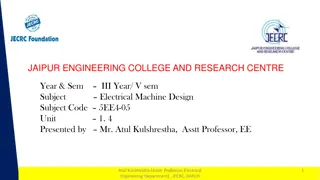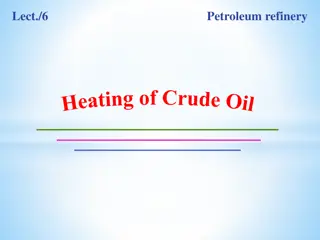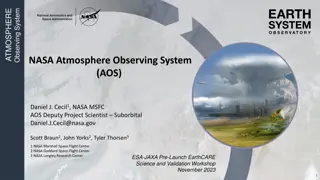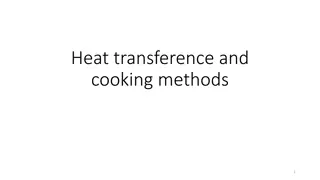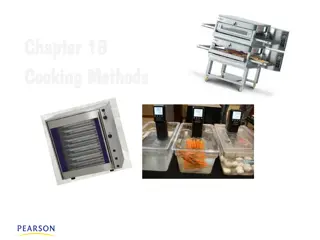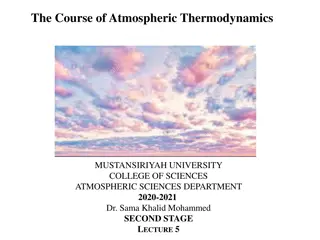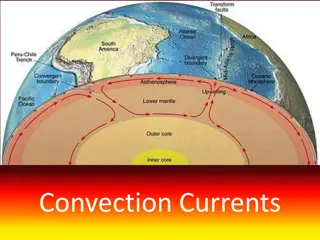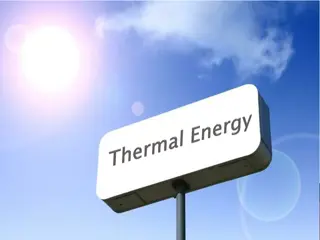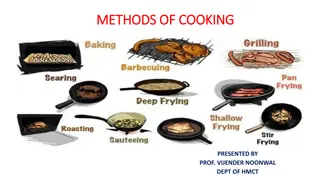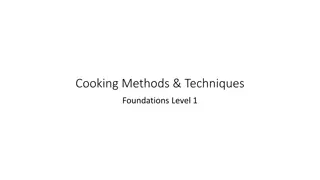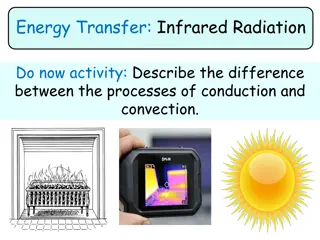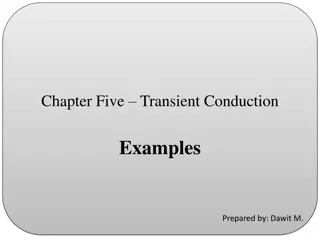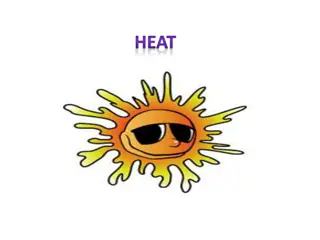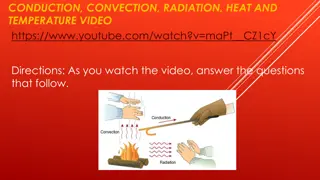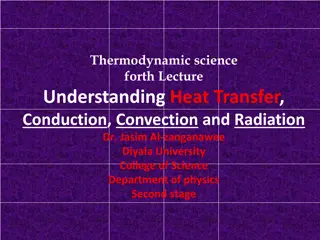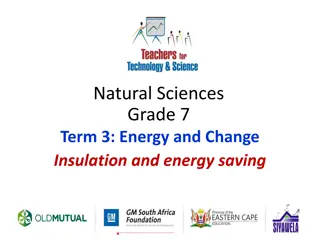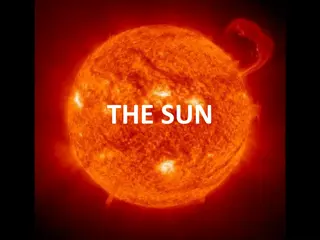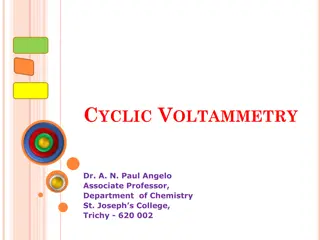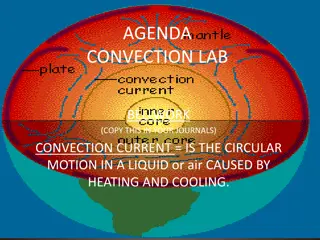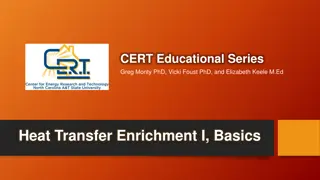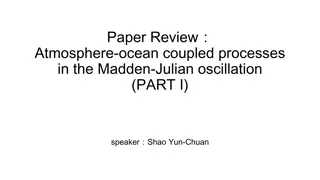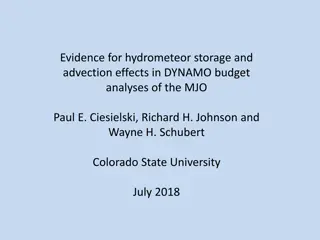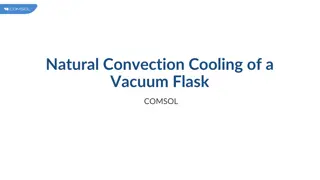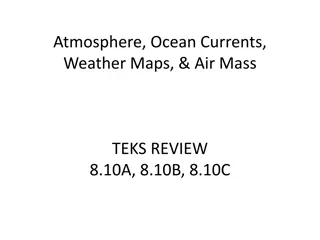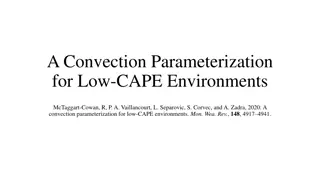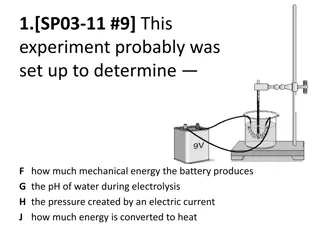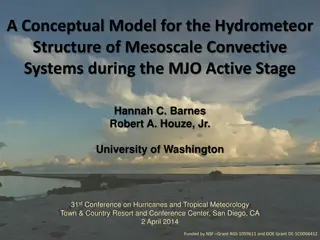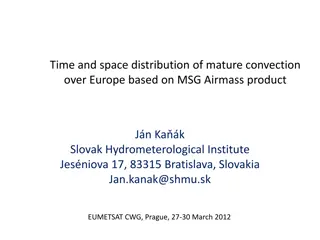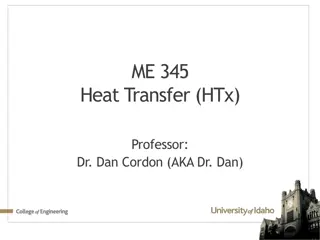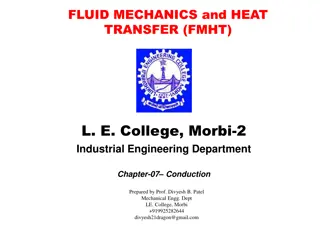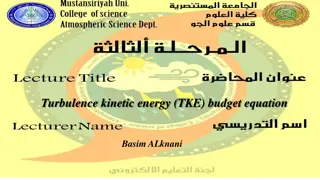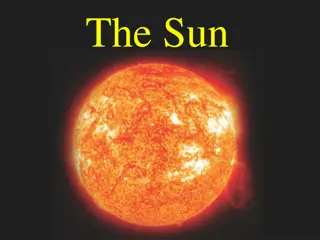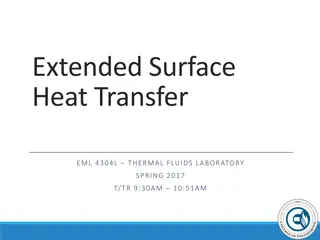Electrical Machine Design: Thermal Considerations and Heat Flow Analysis
This content provides insights into thermal considerations in electrical machine design, focusing on maximum operating temperatures, insulation factors, and heat flow mechanisms through convection, conduction, and radiation. It discusses the impact of temperature on insulation life and the methods o
1 views • 13 slides
Geology Unit Review
This geology unit review covers identifying different processes such as uplift, subduction, and convection, as well as types of volcanoes like cinder cones and composite volcanoes. It also discusses the Pacific Plate and its unique characteristics, along with volcanic activity around the Ring of Fir
2 views • 9 slides
ECE 305 Electromagnetic Theory
Explore the fundamental concepts of electric fields in material space, covering topics such as free space, conductors, insulators, semiconductors, current conduction, and charge density. Delve into the properties of materials, convection vs. conduction current, and the role of superconductors in ele
1 views • 25 slides
Heating of Crude Oil
The process of heating crude oil in petroleum refineries involves various types of furnaces and heat distribution methods. The furnaces can be categorized into box, cylindrical, and radiant wall types, each with separate radiation and convection sections. Design considerations include heat transfer
1 views • 24 slides
NASA Atmosphere Observing System (AOS) Overview
NASA's Atmosphere Observing System (AOS) comprises innovative technologies and instruments to study aerosol, cloud, convection, and precipitation processes. AOS includes the AOS-Storm and AOS-Sky missions, utilizing various sensors like radars, lidars, radiometers, and polarimeters to address key at
0 views • 13 slides
Understanding Heat Transfer and Cooking Methods
Explore the various methods of heat transfer and cooking techniques, including moist-heat and dry-heat methods. Learn about the objectives of heating foods, types of heat transfer such as conduction and convection, and how different methods affect the texture, flavor, and nutritional content of food
0 views • 21 slides
Understanding Cooking Methods: Heat Transfer and Dry-Heat Techniques
Learn about heat transfer methods such as conduction, convection, and radiation, along with dry-heat cooking techniques like sautéing, grilling, roasting, and more. Discover how heat energy is applied in various cooking processes to create delicious dishes.
0 views • 25 slides
Understanding Atmospheric Thermodynamics in Second Stage Lecture
Explore key concepts in atmospheric thermodynamics, including condensation level, free convection level, and the use of thermodynamic diagrams. Learn about the process of condensation, stability levels in the atmosphere, and the significance of free convection in weather patterns. Discover why therm
0 views • 27 slides
Fish Processing and Preservation Methods for Quality and Longevity
Fish are highly perishable and require proper preservation techniques to maintain their quality and freshness. Methods such as chilling, freezing, and other preservation techniques are employed to extend the shelf life of fish for short and long durations. Quick freezing is preferred for long-term s
1 views • 17 slides
Understanding Convection Currents in Earth's Systems
Convection currents refer to the movement of heat by fluids like liquids and gases, transferring heat from one place to another. They play a significant role in the geosphere, atmosphere, and hydrosphere of the Earth, influencing phenomena such as plate tectonics, winds, and ocean currents. In the g
0 views • 12 slides
Understanding Thermal Energy: Transfer & Transformation
Explore thermal energy and its transfer mechanisms such as conduction, convection, and radiation. Learn how thermal energy moves between objects of different temperatures, and why heat is always transferred, not coldness. Enhance your knowledge on the fascinating world of thermal energy dynamics.
0 views • 14 slides
Understanding Cooking Methods: Conduction and Convection Explained
Cooking methods like conduction and convection are fundamental in culinary arts. Conduction involves direct heat transfer through matter, while convection utilizes the movement of fluids for heat transfer. Gravity and buoyancy play crucial roles in natural convection processes, resulting in efficien
1 views • 45 slides
Understanding Cooking Techniques and Their Effects on Food
Cooking methods play a crucial role in transforming food through processes like dry, moist, or combination cooking. Heat transfer methods such as conduction, convection, and radiation influence how food is cooked. Dry cooking techniques use oil or hot air, while moist cooking involves using liquid.
0 views • 9 slides
Understanding Infrared Radiation in Energy Transfer Experiments
Explore the difference between conduction and convection, sources of infrared radiation, and how energy is transferred through radiation. Investigate how different surfaces emit varying levels of infrared radiation using a practical experiment with black and silver tins. Analyze and interpret result
0 views • 11 slides
Transient Conduction in Thermal Energy Storage Units and Cylinders
Explore examples of transient conduction phenomena in thermal energy storage units, cylinders, and spheres. Learn how to calculate time durations, temperature changes, and energy removal rates during these heating and cooling processes. The examples cover scenarios involving aluminum slabs, oil bath
0 views • 10 slides
Understanding Heat Energy Transfer and Principles
Heat energy is the result of particle movement in solids, liquids, and gases. It can be transferred through conduction, convection, and radiation. Conduction occurs through direct contact, convection involves the movement of fluids, and radiation transfers heat through empty space. Understanding how
1 views • 14 slides
Understanding Heat Transfer: Conduction, Convection, Radiation
Explore the concepts of conduction, convection, and radiation in heat transfer through an engaging video. Learn how thermal energy is transferred through solids, liquids, and gases, and understand the role of insulation in preventing heat transfer. Discover why hot water rises and cold water sinks,
0 views • 5 slides
Understanding Heat Transfer in Thermodynamics Lecture
This thermodynamics lecture covers essential topics such as heat transfer, conduction, convection, and radiation. Dr. Jasim Al-zanganawee from Diyala University explains Thermodynamic Processes, Internal Energy, Properties of a System, and Thermodynamic Cycles. Students will learn about extensive an
0 views • 11 slides
Understanding Insulation and Energy Saving in Grade 7 Natural Sciences
Exploring heat loss, gain, and insulation techniques in the context of energy conservation. Topics include solar water heaters, conduction, convection, and radiation as mechanisms for heat transfer.
5 views • 6 slides
The Sun: A Closer Look at Our Star
Exploring the fascinating characteristics of the Sun, we delve into its composition, energy production through nuclear fusion, core processes, radiation and convection zones, and the layers of its atmosphere. Witness the Sun's magnificence and understand the mechanisms that drive its life-giving ene
0 views • 13 slides
Understanding Cyclic Voltammetry in Electrochemical Analysis
Cyclic voltammetry is a crucial electroanalytical technique for studying electrochemical behavior. It involves sweeping potential in a cyclic manner to measure current responses, aiding in understanding redox processes, electron transfer kinetics, and coupled reactions. The technique requires carefu
0 views • 10 slides
Coupled Ocean-Atmosphere Modeling on Icosahedral Grids
Coupled ocean-atmosphere modeling on horizontally icosahedral and vertically hybrid-isentropic/isopycnic grids is a cutting-edge approach to modeling climate variability. The design goals aim to achieve a global domain with no grid mismatch at the ocean-atmosphere interface, with key indicators such
1 views • 21 slides
Understanding Heat Transfer in Science
Investigate and understand the movement of heat between objects through conduction, convection, and radiation. Learn to compare materials that conduct heat with insulating materials, describe heat transfer processes, and design experiments to study heat energy movement. Explore the use of ratio reas
0 views • 31 slides
Explore Convection Currents Lab Activity
Engage students in a hands-on lab activity to observe convection currents in action. The agenda includes bell work about convection, a hypothesis on confetti paper movement in hot water, detailed lab procedures, drawing conclusions with CER format, and thought-provoking conclusion questions related
0 views • 7 slides
Understanding Heat Transfer Fundamentals
Explore the basics of heat transfer through examples like ice melting, jumping into a pool, and more. Learn how temperature differences lead to changes in energy transfer and feel the effects firsthand. Discover the principles of conduction, convection, and radiation in various scenarios that involv
0 views • 11 slides
Understanding Atmosphere-Ocean Coupling in Madden-Julian Oscillation
Atmosphere-ocean coupled processes in the Madden-Julian Oscillation (MJO) play a crucial role in intraseasonal oscillations. This paper review by Shao Yun-Chuan explores how the ocean's Sea Surface Temperature (SST) influences surface fluxes, MJO convection, and energy balance dynamics. It delves in
0 views • 17 slides
Evidence for Hydrometeor Storage and Advection Effects in DYNAMO Budget Analyses of the MJO
Variational constraint analyses (VCA) were conducted for DYNAMO in two regions to compare observed radar rainfall data with conventional budget method results, examining differences and composite analyses of MJO events. The study utilized input data including Gridded Product Level 4 sounding data an
0 views • 13 slides
Modeling Natural Convection Cooling of a Vacuum Flask in COMSOL
This example demonstrates the modeling of natural convection cooling in a vacuum flask holding hot coffee using COMSOL. It compares two approaches to describe thermal dissipation, focusing on calculating the flask's cooling power over time. Results include temperature analysis, heat transfer coeffic
0 views • 11 slides
Atmosphere, Ocean Currents, Weather Maps, & Air Mass TEKS Review
Explore key concepts related to atmosphere, ocean currents, weather maps, and air mass in this TEKS review. Understand the factors contributing to Earth's uneven heating, the role of convection in ocean currents, the energy sources that drive ocean convection, and the effects of heating on air densi
0 views • 21 slides
Convection Parameterization for Low-CAPE Environments
Many global Numerical Weather Prediction systems face challenges predicting convective activity in low-CAPE environments. This study introduces a convection parameterization scheme based on moisture convergence to better represent convective effects. The scheme focuses on the triggering function, up
1 views • 38 slides
Understanding Heat Transfer in Scientific Experiments
Explore various scientific experiments related to heat transfer, including determining energy produced by batteries, heat convection in gases and liquids, detecting warmth through a door, energy transformations in the Earth system, and optimizing solar heaters. Learn about conduction, convection, ra
0 views • 16 slides
Conceptual Model for Hydrometeor Structure of Mesoscale Convective Systems during MJO Active Stage
This study presented a conceptual model for characterizing the hydrometeor structure of Mesoscale Convective Systems (MCSs) during the Madden-Julian Oscillation (MJO) active stage. The research focused on the kinematic structure of MCSs and utilized radar data, compositing methodology, and convectiv
1 views • 24 slides
Understanding Mature Convection Distribution Over Europe
Analyzing the time and space distribution of mature convection over Europe based on MSG Airmass product from Slovak Hydrometeorological Institute. The data covers various timeframes and processing steps, highlighting the dependence on Sun elevation, daytime hours, and monthly variations. Statistical
0 views • 11 slides
Understanding Heat Transfer in Convection: Key Parameters and Correlations
Explore the fundamentals of heat transfer in convection, focusing on external flow, important dimensionless parameters like Nusselt and Sherwood numbers, empirical correlations, film temperature concept, and local laminar flat plate correlations. Learn about key concepts and equations used in analyz
0 views • 26 slides
Understanding Heat Transfer: Conduction, Convection, and Radiation
Heat transfer is a fundamental process that occurs through conduction, convection, and radiation. Conduction involves the transfer of heat between particles through direct contact, while convection moves heat within fluids and gases through currents. Radiation is heat transfer through electromagneti
0 views • 13 slides
Turbulence Kinetic Energy (TKE) Budget Equations Overview
The Turbulence Kinetic Energy (TKE) budget equation explores the different terms contributing to the generation and consumption of turbulence in the atmosphere. It delves into the effects of buoyant production/consumption, mechanical (shear) production, and the importance of Term III in free convect
0 views • 12 slides
Understanding Heat Transfer Methods and Insulation
Explore the various methods of heat transfer such as conduction, convection, and radiation, along with the roles of conductors and insulators in managing heat. Discover why metals feel cool to the touch, how insulated containers work, and the mechanism behind a Thermos. Delve into the concepts of co
0 views • 14 slides
Exploring the Structure and Phenomena of the Sun
Discover the intricate balance and core structure of the Sun, maintained by hydrostatic equilibrium. Energy moves through radiation and convection zones, with convection manifesting as granulation on the photosphere. Eclipses, such as solar eclipses, provide unique opportunities to witness celestial
0 views • 12 slides
Understanding Extended Surface Heat Transfer in Thermal Fluids Laboratory
This laboratory explores heat transfer in a single cylindrical extended surface (a fin) under free and forced convection to understand fin effectiveness and influencing parameters. Various types of fins like rectangular, triangular, annular, and pin fins are discussed, along with primary modes of he
0 views • 19 slides
Understanding Heat Transfer: A Comprehensive Overview
Heat transfer is a fundamental concept in physics, where energy moves from hot to cold objects through conduction, radiation, and convection. Heat is not a substance but a form of energy that speeds up molecules. Conduction transfers heat between substances in direct contact, while convection involv
0 views • 13 slides
